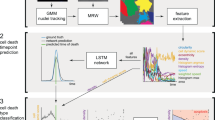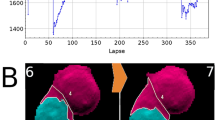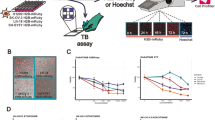Abstract
Several cell death assays have been developed based on a single biochemical parameter such as caspase activation or plasma membrane permeabilization. Our fluorescent apoptosis/necrosis (FAN) assay directly measures cell death and distinguishes between caspase-dependent apoptosis and caspase-independent necrosis of cells grown in any multiwell plate. Cell death is monitored in standard growth medium as an increase in fluorescence intensity of a cell-impermeable dye (SYTOX Green) after plasma membrane disintegration, whereas apoptosis is detected through caspase-mediated release of a fluorophore from its quencher (DEVD-amc). The assay determines the normalized percentage of dead cells and caspase activation per condition as an end-point measurement or in real time (automated). The protocol can be applied to screen drugs, proteins or siRNAs for interference with cell death while simultaneously detecting cell death modality switching between apoptosis and necrosis. Initial preparation may take up to 5 d, but the typical hands-on time is ∼2 h.
This is a preview of subscription content, access via your institution
Access options
Subscribe to this journal
Receive 12 print issues and online access
$259.00 per year
only $21.58 per issue
Buy this article
- Purchase on Springer Link
- Instant access to full article PDF
Prices may be subject to local taxes which are calculated during checkout


Similar content being viewed by others
References
Jouan-Lanhouet, S. et al. Necroptosis, in vivo detection in experimental disease models. Semin. Cell Dev. Biol. 35, 2–13 (2014).
Linkermann, A. et al. The potential role of necroptosis in diseases. Necrotic Cell Death Vol. 2 (eds. Shen, H. & Vandenabeele, P.) 1–21 (Humana Press, 2014).
Murphy, J.M. & Silke, J. Ars Moriendi; the art of dying well – new insights into the molecular pathways of necroptotic cell death. EMBO Rep. 15, 155–164 (2014).
Vanden Berghe, T., Linkermann, A., Jouan-Lanhouet, S., Walczak, H. & Vandenabeele, P. Regulated necrosis: the expanding network of non-apoptotic cell death pathways. Nat. Rev. Mol. Cell Biol. 15, 135–147 (2014).
Vanden Berghe, T., Kaiser, W.J., Bertrand, M.J.M. & Vandenabeele, P. Molecular crosstalk between apoptosis, necroptosis and survival signaling. Mol. Cell. Oncol. 2, e975093 (2015).
Vercammen, D., Vandenabeele, P., Beyaert, R., Declercq, W. & Fiers, W. Tumour necrosis factor-induced necrosis versus anti-Fas-induced apoptosis in L929 cells. Cytokine 9, 801–808 (1997).
Dondelinger, Y. et al. RIPK3 contributes to TNFR1-mediated RIPK1 kinase-dependent apoptosis in conditions of cIAP1/2 depletion or TAK1 kinase inhibition. Cell Death Differ. 20, 1381–1392 (2013).
Kalai, M. et al. Tipping the balance between necrosis and apoptosis in human and murine cells treated with interferon and dsRNA. Cell Death Differ. 9, 981–994 (2002).
Lawlor, K.H. et al. RIPK3 promotes cell death and NLRP3 inflammasome activation in the absence of MLKL. Nat. Commun. 6, 6282 (2015).
Remijsen, Q. et al. Depletion of RIPK3 or MLKL blocks TNF-driven necroptosis and switches towards a delayed RIPK1 kinase-dependent apoptosis. Cell Death Dis. 5, e1004 (2014).
Vanden Berghe, T., Kalai, M., van Loo, G., Declercq, W. & Vandenabeele, P. Disruption of HSP90 function reverts tumor necrosis factor-induced necrosis to apoptosis. J. Biol. Chem. 278, 5622–5629 (2003).
Vanden Berghe, T. et al. Differential signaling to apoptotic and necrotic cell death by Fas-associated death domain protein FADD. J. Biol. Chem. 279, 7925–7933 (2004).
Zhang, D.W. et al. RIP3, an energy metabolism regulator that switches TNF-induced cell death from apoptosis to necrosis. Science 325, 332–336 (2009).
Lindhagen, E., Nygren, P. & Larsson, R. The fluorometric microculture cytotoxicity assay. Nat. Protoc. 3, 1364–1369 (2008).
Mosmann, T. Rapid colorimetric assay for cellular growth and survival: application to proliferation and cytotoxicity assays. J. Immunol. Methods 65, 55–63 (1983).
O'Brien, J., Wilson, I., Orton, T. & Pognan, F. Investigation of the Alamar Blue (resazurin) fluorescent dye for the assessment of mammalian cell cytotoxicity. Eur. J. Biochem. 267, 5421–5426 (2000).
Rossi, C. et al. Identifying druglike inhibitors of myelin-reactive T cells by phenotypic high-throughput screening of a small-molecule library. J. Biomol. Screen. 12, 481–489 (2007).
Grootjans, S., Goossens, V., Vandenabeele, P. & Vanden Berghe, T. Methods to study and distinguish necroptosis. in Necrotic Cell Death Vol. 2 (eds. Shen, H. & Vandenabeele, P.) 335–361 (Humana Press, 2014).
Vanden Berghe, T. et al. Determination of apoptotic and necrotic cell death in vitro and in vivo. Methods 61, 117–129 (2013).
Riccardi, C. & Nicoletti, I. Analysis of apoptosis by propidium iodide staining and flow cytometry. Nat. Protoc. 1, 1458–1461 (2006).
Vanden Berghe, T. et al. Necroptosis, necrosis and secondary necrosis converge on similar cellular disintegration features. Cell Death Differ. 17, 922–930 (2010).
Demon, D. et al. Proteome-wide substrate analysis indicates substrate exclusion as a mechanism to generate caspase-7 versus caspase-3 specificity. Mol. Cell Proteomics 8, 2700–2714 (2009).
Thornberry, N.A., Chapman, K.T. & Nicholson, D.W. Determination of caspase specificities using a peptide combinatorial library. Methods Enzymol. 322, 100–110 (2000).
Denecker, G. et al. Death receptor-induced apoptotic and necrotic cell death: differential role of caspases and mitochondria. Cell Death Differ. 8, 829–840 (2001).
Dondelinger, Y. et al. MLKL compromises plasma membrane integrity by binding to phosphatidylinositol phosphates. Cell Rep. 7, 971–981 (2014).
Estornes, Y. et al. RIPK1 promotes death receptor-independent caspase-8-mediated apoptosis under unresolved ER stress conditions. Cell Death Dis. 5, e1555 (2014).
Dondelinger, Y. et al. NF-κB-independent role of IKKα/IKKβ in preventing RIPK1 kinase-dependent apoptotic and necroptotic cell death during TNF signaling. Mol. Cell 60, 63–76 (2015).
Aaes, T.L. et al. Vaccination with necroptotic cancer cells induces efficient anti-tumor immunity. Cell Rep. 15, 274–287 (2016).
Krysko, O., De Ridder, L. & Cornelissen, M. Phosphatidylserine exposure during early primary necrosis (oncosis) in JB6 cells as evidenced by immunogold labeling technique. Apoptosis 9, 495–500 (2004).
Thal, S.E., Zhu, C., Thal, S.C., Blomgren, K. & Plesnila, N. Role of apoptosis inducing factor (AIF) for hippocampal neuronal cell death following global cerebral ischemia in mice. Neurosci. Lett. 499, 1–3 (2011).
Zhang, J. et al. EndoG links Bnip3-induced mitochondrial damage and caspase-independent DNA fragmentation in ischemic cardiomyocytes. PLoS ONE 6, e17998 (2011).
Aguer, C. et al. Galactose enhances oxidative metabolism and reveals mitochondrial dysfunction in human primary muscle cells. PLoS ONE 6, e28536 (2011).
Roth, B.L., Poot, M., Yue, S.T. & Millard, P.J. Bacterial viability and antibiotic susceptibility testing with SYTOX green nucleic acid stain. Appl. Environ. Microbiol. 63, 2421–2431 (1997).
Fukunaga, M. & Yielding, L.W. Structure-function characterization of phenanthridinium compounds as mutagens in Salmonella. Mutat. Res. 121, 89–94 (1983).
Kraman, M. et al. Suppression of antitumor immunity by stromal cells expressing fibroblast activation protein-α. Science 330, 827–830 (2010).
Pasparakis, M. & Vandenabeele, P. Necroptosis and its role in inflammation. Nature 517, 311–320 (2015).
Degterev, A. et al. Identification of RIP1 kinase as a specific cellular target of necrostatins. Nat. Chem. Biol. 4, 313–321 (2008).
Cho, Y.S. et al. Phosphorylation-driven assembly of the RIP1-RIP3 complex regulates programmed necrosis and virus-induced inflammation. Cell 137, 1112–1123 (2009).
He, S. et al. Receptor interacting protein kinase-3 determines cellular necrotic response to TNF-α. Cell 137, 1100–1111 (2009).
Feng, S. et al. Cleavage of RIP3 inactivates its caspase-independent apoptosis pathway by removal of kinase domain. Cell. Signal. 19, 2056–2067 (2007).
Yang, W.S. et al. Regulation of ferroptotic cancer cell death by GPX4. Cell 156, 317–331 (2014).
Acknowledgements
We acknowledge the following members of our laboratory: Q. Remijsen for his contribution to the initial development of the assay, and R. Roelandt, S. Martens, M. Aguileta and Y. Estornes for sharing data that were not included in the final manuscript. We acknowledge D. Fearon, University of Cambridge, for his kind gift of LL2-OVA cells. We are grateful to A. Bredan for editing the manuscript. Research in the Vandenabeele group is supported by Belgian grants (Interuniversity Attraction Poles, IAP 7/32), Flemish grants (Research Foundation Flanders: FWO G.0875.11, FWO G.0973.11, FWO G.0A45.12N, FWO G.0172.12, FWO G.0787.13N, FWO G.0607.13N, FWO KAN 31528711, FWO KAN 1504813N, FWO G0E04.16N), Methusalem grant (BOF09/01M00709 and BOF16/MET_V/007), Ghent University grants (MRP, GROUP-ID consortium, BOF14/GOA/019), a grant from the Foundation Against Cancer (2012-188) and grants from VIB. P.V. holds Methusalem grants (BOF09/01M00709 and BOF16/MET_V/007).
Author information
Authors and Affiliations
Contributions
S.G. and Y.D. developed the protocol. S.G., M.V., V.G., T.V.B. and P.V. designed the research, interpreted the data and wrote the paper. S.G., B.H., I.D. and B.W. carried out the experiments. M.V. performed the repeated-measurements data analysis. M.J.M.B. and D.V.K. provided critical remarks and discussion.
Corresponding authors
Ethics declarations
Competing interests
The authors declare no competing financial interests.
Integrated supplementary information
Supplementary Figure 1 Validation of the FAN assay
a, The linear range for SYTOX Green decreases at lower concentrations (< 5μM) even if signal intensity is below the saturation level of the detector. b- c, Cell membrane permeabilization kinetics (b) and caspase activation (c) in IMR-32 cells treated with 2 μM Staurosporin (STS). d- e The effect of DEVD-amc on propidium iodide (PI) intensity and vice versa. Fas-overexpressing L929 cells were treated with 250 ng/ml anti-Fas antibody in the presence or absence of 20 μM DEVD-amc or 10μM PI, and amc intensity (d) and PI intensity (e) was measured 30 h later. f, The effect of phenol red on PI intensity is minimal for permeabilized L929 cells. g- h, Cell membrane permeabilization kinetics measured with 10μM PI (g) and caspase activation (h) in L929-Fas cells treated with anti-Fas Ab (250 ng/ml). The same plate was measured at 6 and 30 hours after stimulation, and returned to the tissue culture incubator in the interval time. Error bars = standard error of the mean, obtained from three independent experiments (n=3), each measured in triplicate. ***, p ≤ 0.001. Non-significant differences are not indicated. AV, arbitrary values.
Supplementary information
Supplementary Text and Figures
Supplementary Figures 1 and 2, Supplementary Table and Supplementary Note (PDF 747 kb)
Rights and permissions
About this article
Cite this article
Grootjans, S., Hassannia, B., Delrue, I. et al. A real-time fluorometric method for the simultaneous detection of cell death type and rate. Nat Protoc 11, 1444–1454 (2016). https://doi.org/10.1038/nprot.2016.085
Published:
Issue Date:
DOI: https://doi.org/10.1038/nprot.2016.085
This article is cited by
-
Nontypeable Haemophilus influenzae released from biofilm residence by monoclonal antibody directed against a biofilm matrix component display a vulnerable phenotype
Scientific Reports (2023)
-
Detection of apoptotic cells based on in situ hybridization chain reaction using specific hairpins
Apoptosis (2023)
-
Cancer cells dying from ferroptosis impede dendritic cell-mediated anti-tumor immunity
Nature Communications (2022)
-
Novel porphyrazine-based photodynamic anti-cancer therapy induces immunogenic cell death
Scientific Reports (2021)
-
TNF-α synergises with IFN-γ to induce caspase-8-JAK1/2-STAT1-dependent death of intestinal epithelial cells
Cell Death & Disease (2021)
Comments
By submitting a comment you agree to abide by our Terms and Community Guidelines. If you find something abusive or that does not comply with our terms or guidelines please flag it as inappropriate.



